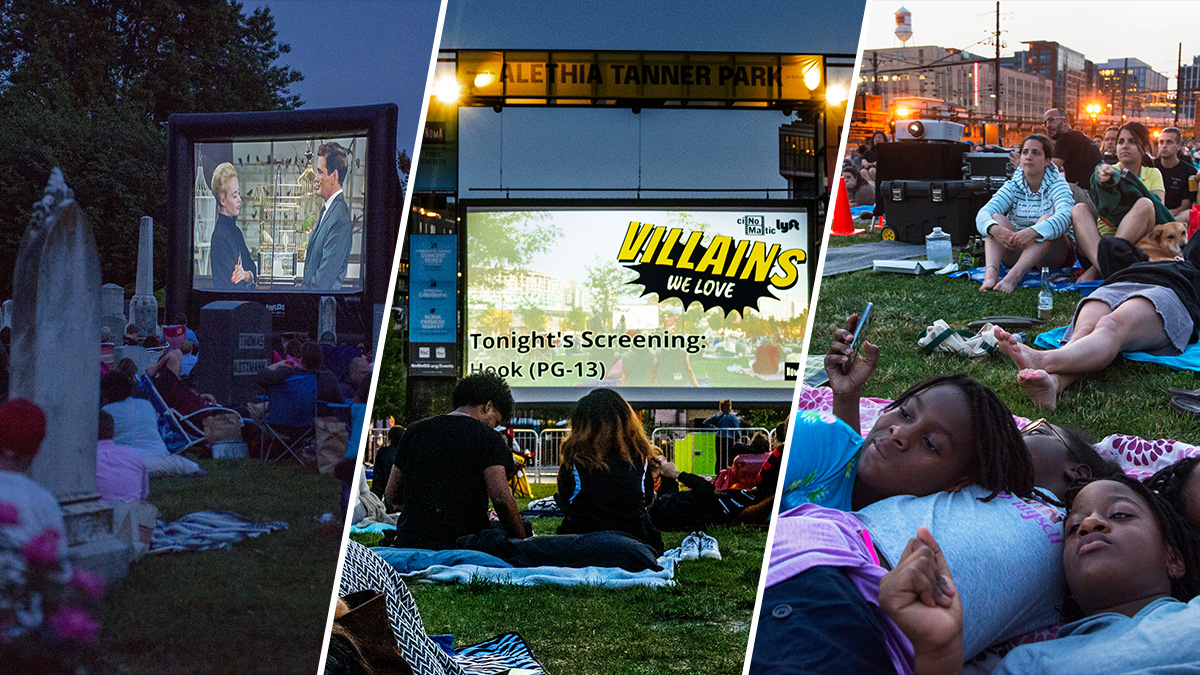
Editor's Note: Temperance Alley Garden's lease was extended to Jan. 1, 2024.
At Temperance Alley Garden, you are standing in what once was -- and will soon be again -- someone’s living room.
From the 1800s to the 1950s, the space held alley dwellings along the U Street corridor in Northwest D.C. Right now, it is a COVID-era community garden. On Sept. 30, when the garden's lease ends, it will be turned into townhomes.
"You're standing in somebody's living room in the past and you're standing in somebody's living room in the future," U Street Neighborhood Association President Aaron Lewis said. "And right now, we're in the special window in time where it's somehow impossibly a garden."
We're making it easier for you to find stories that matter with our new newsletter — The 4Front. Sign up here and get news that is important for you to your inbox.
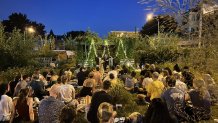
A Time Machine
Centuries before it was a garden, the Anacostans were stewards of the land. When Congress declared the swamplands of D.C. the nation's capital in the 1790s, it became a part of the U.S. In Pierre Charles L’Enfant's plans for the City of Washington, it was known as Square 274, according to the U Street Neighborhood Association's Temperance Alley Garden timeline.
The alley was occupied between the 1800s and 1950s. Its first residents were freed slaves who migrated to D.C. following the Civil War, Lewis said. In the alley, they found cheap shack-like houses with no plumbing, heat or sewage systems.
In the early 1900s, the poor conditions of alley dwellings caught the attention of Congress. By 1934, the Alley Dwellings Authority was created to clear D.C.'s alleys of homes and occupants.
Over the years, working-class Black people established a close, supportive community known as Temperance Court. In 1953, the 23 townhomes in the alley were torn down, displacing over 130 residents, according to the U Street Neighborhood Association. At a Land Acknowledgement Ceremony, Ben's Chili Bowl Owner Virginia Ali said she knew someone who lived in Temperance Court before it was demolished.
The homes were never rebuilt, and part of the alley came to be used as a parking lot. Decades later, in the 2000s, several attempts were made to create affordable housing in the alley. The area was also used for a farmers' and artists' market.
During COVID-19, Lewis and his roommates were stuck inside their rowhouse near the alley and contacted EastBanc, the developer who acquired the property in 2012, and received a temporary lease for a park.
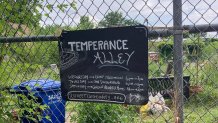
"I've been very impressed with the energy that the team running the garden has brought to it," EastBanc redevelopment manager Hope Richardson said. "You see a lot of community volunteer-run initiatives that start with a lot of enthusiasm and fizzle because people move on, or people get busy."
Now, throughout the garden, there are layers of the alley's past that the stewards excavate like amateur archeologists, including broken pieces of parking lot asphalt, empty oyster shell husks, brown clay pottery pieces and bricks of sunbaked faded reds.
“We really try to engage people that time machine element with the deeper past and help them picture what it was like, so they feel a greater sense of connection to this neighborhood,” Temperance Alley Garden Chair Josh Morin said.
On Garden Time
Over a three-year lease, the stewards transformed a vacant lot slated for construction into a pop-up community garden. The area is tucked behind homes, making it a peaceful retreat from the bustling bar-filled noise of U Street and its Metro station.
The garden appears at first glance to be just a fence protecting overgrown weeds, but beyond its entrance it is a series of intentional spaces, an urban rewilding experiment. Once inside, you can hear birds chirp as city noises become muffled and calm settles in.
“U Street's like the come-up and then the garden can be the comedown," Morin said.
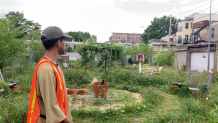
In the space's Welcome Womb, visitors enter a circle of found items inside a knee-length wall of plants, like a labyrinth or clock. This is where weekly meditations are held and where a Little Free Library is located. Walk through an arch to the Lawn, a grassy open area where people sit to watch concerts, do yoga and attend the garden's events.
“I would say Temperance Garden is a learning landscape, an urban farm, a time machine and a construction site,” Lewis said. “And it's a place where neighbors come together to host a lot of different classes, workshops, experiences where we can learn together, create art together and grow together.”
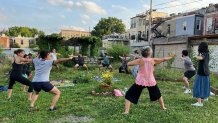
An overgrown Virginia Creeper winds its way up from the ground, creating a green roof on a wooden pergola with a brick floor and chairs. The stewards consider the Pavilion to be the garden’s outdoor living room and a “reanimated ruin” -- the only thing left of the 2000s market.
A thriving mulberry tree and vegetables that grow in wood or brick planter boxes mark the Café Garden behind the Pavilion. Hand-painted signs identify hot peppers, tomatoes, the leafy beginnings of eggplants and dormant vines of watermelons.
Volunteers grow the produce along with Farm the District. They take some of the produce home, share recipes in the garden's homemade zine and donate some of it to Martha’s Table.

Among the vegetables, the Story Circle is a black geodesic dome with campfire energy, Lewis said. Pillows and tree stumps are used for seating; a hanging "dynamic" talking stick is meant to facilitate sharing.
"Whether you're new to the neighborhood or you've been around here for 50 years and seen it completely transform, the storytelling, the connection with people that aren't just in your immediate vicinity, is sort of the whole purpose of this outdoor community space," Morin said as he sat inside the Story Circle among wildflowers and plants.
At the back of the garden is the "time capsule," a black chest with gold buckles that sits closed on a platform of light stone. It is filled with items found in the garden, writings, art, poems, signs, bucket lists and a scrapbook. In front of it, a bench looks back into the green tangles of the garden.
Lewis described it as a seed vault or memory bank of all of their event ideas: something they will keep once the garden is gone, "to reanimate other places that we want to help bring to life in the future."
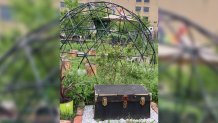
‘A Moment in Time’
Though its stewards are counting the days wistfully (and literally: "144," Morin said on May 9), Lewis and Morin both emphasized the project was created with an end date in mind.
The stewards are planning a full schedule for the garden's final season of events; it's D.C.'s last chance to get to U Street and experience the garden.
"For season three of the garden, we're doing everything a little bigger," Lewis said.
Each event will be headed by a neighbor, volunteer or partner organization that wants to share their passion with the neighborhood, Morin said. You'll find theater, art, music, mind and body events, gardening and meditation.

Alexander Currey said he helps organize the garden workdays and hosts a meditation circle on Wednesdays. He credits the garden with giving him and other volunteers a place to express themselves outside of work.
"It was such a fulfilling project for me, both from a social standpoint, but also just, you know, how I want to live in community and how I want to show up in the city that I call home," Currey said.
For Sara Mack, who is helping organize the events this summer, the garden was the perfect space for this time in her life.
"It's hard to see that go away, but it is also just a really important lesson in appreciating what you have, regardless of the timeframe that you have it," Mack said.
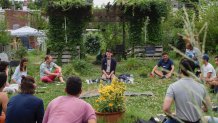
June Events:
- Volunteer Gardening Hours: June 17 and 24; 11 a.m.- 2 p.m.
- Juggling for Everyone: June 17; 5-6:30 p.m.
- Craft in the Garden: June 19; 6:30-8 p.m.
- Yoga in the Garden: June 20; 6-7 p.m.
- Secret Cacao Garden: June 20; 5-8 p.m.
- Group Meditation: June 21 and 28; 6-7 p.m.
- Open Songwriting Hours: June 22; 6-8 p.m.
- Tea Time with Tanya: June 22; 7-8:30 p.m.
- "Your Ass Is Grass" Comedy Show: June 23; 7-9 p.m.
- Summer Solstice 🌞 Celebration: June 24; 6-9 p.m.
- PALC at the PARK: June 28; 6-8 p.m.
- Music in the Garden: June 30; 7-9 p.m.
For a full list of the garden's events, visit the U Street Neighborhood Association website.
Want to know what's up for your weekend? Sign up for The Weekend Scene, our newsletter about events, experiences and adventures for you and for your family around the DMV.

